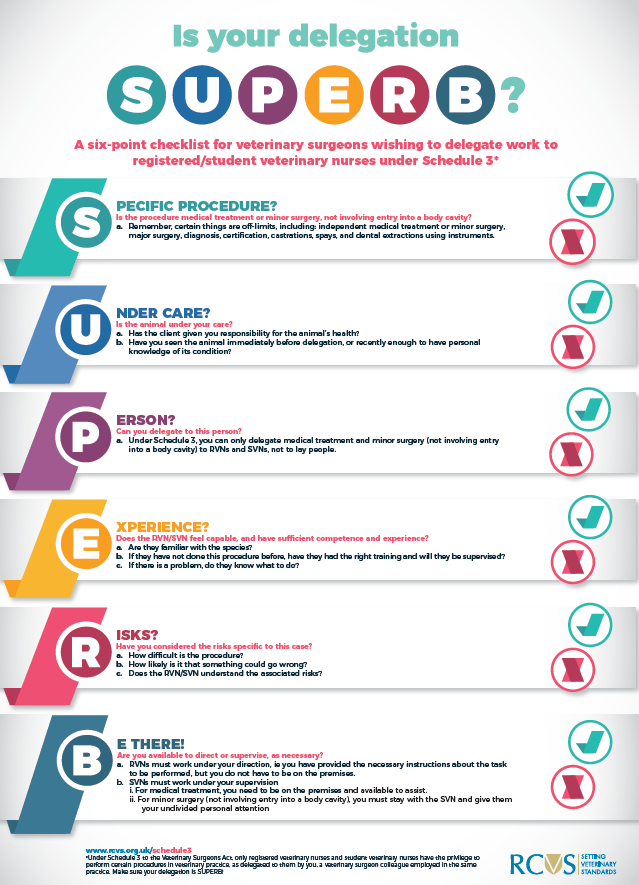
As a vet in small animal practice for over 20 years, I have often been amazed that there are practices where RVNs are not used to their full potential, nor trusted to perform tasks they are more than capable of. Aside from any of the (very important) aspects of job satisfaction and feeling a valued member of the team, surely from a business perspective it makes little sense for the more highly paid vets to be performing a task or procedure that an RVN could do (and potentially do better)?
What tasks can be delegated to veterinary nurses?
It is standard in veterinary practice that, in addition to other tasks, RVNs are monitoring anaesthesia or sedation, performing nurse consultations such as nail clipping and anal gland emptying, and restraining animals for the veterinary surgeons. They will also be caring for inpatients and administering medication. But in many practices, this will be expanded to include:
- Administering second or third vaccinations
- Taking samples: blood tests, urinary samples (via catheter), ear cytology, fine needle aspirates and skin scrapes
- Performing imaging: X-ray, ultrasound or CT scanning
- Placing intravenous cannulae, inserting ET tubes and passing endoscopes
- “Schedule 3” procedures, including minor surgery
- Routine dental hygiene work
- Administering anaesthesia (but only if it is a specific quantity of medication as advised by a veterinary surgeon)
- More advanced consulting such as palliative care discussions, diabetic clinics, etc
Section 18 of the RCVS Code of Professional Conduct (CoPC) gives further information on what tasks can be delegated to RVNs. The RCVS has also produced a “SUPERB” poster (Figure 1) to help clarify what can be delegated under Schedule 3.
They have avoided making an exhaustive list of what can and cannot be performed by an RVN, but section 18.7 of the CoPC states:
“In considering whether to direct a veterinary nurse or student veterinary nurse to carry out ‘Schedule 3 procedures’, a veterinary surgeon must consider how difficult the procedure is in the light of any associated risks, whether the nurse is qualified to treat the species concerned, understands the associated risks and has the necessary experience and good sense to react appropriately if any problem should arise. The veterinary surgeon must also be sure that they will be available to answer any call for assistance, and finally, should be satisfied that the nurse feels capable of carrying out the procedure competently and successfully.”
In December 2024, the British Veterinary Nursing Association (BVNA) released an article on maximising the RVN role under current legislation, which gives further details about what can and cannot be delegated under Schedule 3.

How can we support veterinary nurses?
So, how do we ensure that nurses are able, and more importantly, feel able, to fulfil their potential and how can this help a practice to work more efficiently?
Two-way communication
On the surface, it may seem that an equally shared rota… is the fairest way to work. However, it may suit the individual members of the team better to distribute the roles differently
As is the case with most situations, communication is key. Talk to the nurses in your team and listen to what they want to do. Not all nurses want to perform Schedule 3 procedures, and that is OK. First of all, find out where the interests and strengths lie within your team. On the surface, it may seem that an equally shared rota between, for example, theatre, consulting and kennels is the fairest way to work. However, it may suit the individual members of the team better to distribute the roles differently and therefore end up with a happier team and a more efficient structure.
Build trust
In any circumstance, I would expect a colleague to speak up and say if they are not comfortable or if they would like support
I will, as a vet, slip in at this point that trust is incredibly important when I am delegating tasks to nurses (or, indeed, to another vet). If a fellow professional says they can perform a procedure, I need to have confidence that they are telling the truth and that (1) it will be done in a timely manner, and (2) it will be done well. In any circumstance, I would expect a colleague to speak up and say if they are not comfortable or if they would like support. It is equally reasonable for them to expect the person delegating to provide that support or to make alternative arrangements as appropriate.
Create a clinical skills matrix
So, we’ve established which members of the nursing team are interested in performing certain roles; if, for the purposes of this article, we focus on performing Schedule 3 procedures, it is very useful to complete a clinical skills matrix for all staff. An example is given in Table 1.
| Skill | Confident | Needs support | Cannot do |
| IV cannula placement | |||
| Blood sample | |||
| Intubation | |||
| X-rays | |||
| Ultrasound | |||
| Scale and polish | |||
| Dental X-rays | |||
| Dental charting | |||
| Dental nerve blocks | |||
| Stitch up | |||
| Lump removal | |||
| Passing urinary catheter |
Of course, this is just an example and can be amended as necessary for your practice. It is a simple way of seeing both where support is needed and who can provide that support. There may be a need for additional resources, such as X-ray positioning guides, or a training session from an external provider on skills such as dental X-rays and nerve blocks, if there is no one in the practice confident enough to teach. There are some excellent CPD courses on Schedule 3 procedures, which have given the nurses I work with the confidence to come back and use what they have learned. They have also been practising suturing on fake skin, as well as the odd chicken thigh.
Provide opportunities for practical work
The most important thing back in the clinic is to provide as much opportunity for practical work as possible. It is not always easy if things are busy, and we tend to get into a routine, such that you sometimes must actively remember to ask someone else to do a procedure such as intubation. However, although it may take marginally longer in the short term to provide teaching support, in the long term the efficiency of the clinic will be improved dramatically.
In my experience, nothing knocks confidence more quickly than being left to perform a procedure with inadequate support and the result of a poor outcome
Once everyone is confident and happy, we can, for example, have nurses taking radiographs while the vet is consulting instead of waiting for them to finish. A dentistry patient can (once anaesthetised) have a full charting, scale and polish, X-rays and local nerve blocks performed while the vet is busy elsewhere – only needing to be present for extractions. A nurse can be removing a mass or suturing a wound, while the vet is simultaneously performing a more complex procedure.
To get to this point, however, nurses must be provided with ongoing support and training when needed or requested. In my experience, nothing knocks confidence more quickly than being left to perform a procedure with inadequate support and the result of a poor outcome. Of course, there will always be complications or unexpected outcomes, and these can be discussed openly within a no-blame culture.
Final thoughts
In summary, there are many practices that are not fully utilising their nursing team, but giving the support and space for development will improve satisfaction in the workplace for the whole clinical team, as well as improving efficiency and increasing the workflow in practice.







